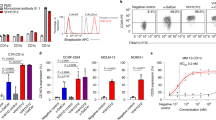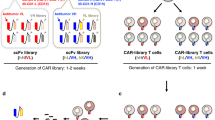Abstract
The I–J determinant of membrane glycoprotein is known to be expressed exclusively on suppressor T cells (Ts), which have a crucial role in the regulation of immune responses1. I–J also comprises part of the soluble factor (TsF) with suppressor activity which is secreted from Ts. Gene-mapping experiments have indicated that the I–J gene lies between the I–A and I–E subregions of the mouse major histocompatibility complex (MHC)2,3 and is defined by the H–2 congeneic pair, that is, B10.A(3R) and B10.A(5R)4. In fact, antibodies raised in the reciprocal combinations of B10.A(3R) and B10.A(5R) define the I–Jb and I–Jk alleles, and are able to detect the I–J determinants on Ts and TsF. Biochemical and functional analyses5–10, using I–J-positive Ts clones and hybridomas, have demonstrated that monoclonal anti-I–J antibodies precipitate I–Jk or I–Jb with a relative molecular mass of 25,000–28,000 (25–28K) and that the I–J+ molecule mediates the restriction specificity of TsF in. association with an antigen-binding protein (45K). However, molecular genetic studies on the I–J gene11–13 reveal no genetic difference between B10.A(3R) and B10.A(5R) and also that there is no room to accommodate a gene encoding I–J in the expected I region. These discrepancies between the molecular genetic and serological/functional data require explanation. Here we demonstrate that Ts and TsF expressing I–J of the host type were produced by fully allogeneic bone marrow cells of donor origin in chimaeric mice, when the chimaeras received the host antigen-presenting cells (APC) at the time of immunization. The results show that APC are necessary for the activation and clonal expansion of Ts and also support the notion that I–J is an idiotypic determinant of the recognition component of Ts and TsF.
This is a preview of subscription content, access via your institution
Access options
Subscribe to this journal
Receive 51 print issues and online access
$199.00 per year
only $3.90 per issue
Buy this article
- Purchase on Springer Link
- Instant access to full article PDF
Prices may be subject to local taxes which are calculated during checkout
Similar content being viewed by others
References
Tada, T. & Okumura, K. Adv. Immun. 28, 1–87 (1979).
Murphy, D. B., Herzenberg, L. A., Okumura, K., Herzenberg, L. A. & McDevitt, H. O. J. exp. Med. 144, 699–712 (1976).
Tada, T., Taniguchi, M. & David, C. J. exp. Med. 144, 713–726 (1976).
Stimpfling, J. H. & Reichert, A. E. Transplantn Proc 2, 39–47 (1970).
Taniguchi, M. et al. Nature 298, 172–174 (1982).
Saito, T. & Taniguchi, M. J. molec. cell. Immun. 1, 137–145 (1984).
Sumida, T., Takei, I. & Taniguchi, M. J. Immun. 133, 1131–1136 (1984).
Taniguchi, M., Tokuhisa, T., Itoh, T. & Kanno, M. J. exp. Med. 159, 1096–1104 (1984).
Taniguchi, M., Takei, I. & Sumida, T. Immunogenetics—Its Applications to Clinical Medicine (eds Sasasuki, T. & Tada, T.) 203–210 (Academic, New York, 1984).
Kumagai, Y., Okumura, K. & Tada, T. Molec. Immun. 21, 545–559 (1984).
Steinmetz, M. et al. Nature 300, 35–42 (1982).
Kronenberg, M. et al. Proc. natn. Acad. Sci. U.S.A. 80, 5704–5708 (1983).
Kobori, J. A., Winoto, A., McNicholas, J. & Hood, L. J. molec. cell. Immun. 1, 125–131 (1984).
Aizawa, S., Sado, T., Muto, M. & Kubo, E. J. Immun. 127, 2426–2431 (1981).
Taniguchi, M., Tada, T. & Tokuhisa, T. J. exp. Med. 144, 20–31 (1976).
Hirokawa, K. et al. J. Immun. 134, (in the press).
Takaoki, M. et al. J. exp. Med. 156, 1325–1334 (1982).
Lowy, A. et al. J. exp. Med. 157, 353–358 (1983).
Schrader, J. Scand. J. Immun. 10, 387–393 (1979).
Kurata, A. et al. J. molec. cell. Immun. 1, 267–277 (1984).
Murphy, D. B. J. molec. cell. Immun. 1, 133–135 (1984).
Jones, P. P., Murphy, D. B. & McDevitt, H. O. Immunogenetics 12, 321–337 (1981).
Katz, D. H., Katz, L. R. & Bogowitz, C. A. Cell. Immun. 42, 124–138 (1979).
Author information
Authors and Affiliations
Rights and permissions
About this article
Cite this article
Sumida, T., Sado, T., Kojima, M. et al. I–J as an idiotype of the recognition component of antigen-specific suppressor T-cell factor. Nature 316, 738–741 (1985). https://doi.org/10.1038/316738a0
Received:
Accepted:
Issue Date:
DOI: https://doi.org/10.1038/316738a0
This article is cited by
-
Antigen-specific suppressor factor: Missing pieces in the puzzle
Immunologic Research (1995)
-
The I-J-disparate mouse strains B10.A(3R) and B10.A(5R) have identical E? sequences
Immunogenetics (1990)
-
Modulation of low-dose streptozotocin-induced diabetes in mice by administration of antibodies to I-A, I-E and I-J determinants
Diabetologia (1989)
-
I-J-positive cloned macrophages as accessory cells for the induction of suppressor T cells in vitro
Immunologic Research (1986)
-
Cell-cell interaction responsible for the induction of first order suppressor T cells in hapten-specific contact sensitivity reactions
Immunologic Research (1986)
Comments
By submitting a comment you agree to abide by our Terms and Community Guidelines. If you find something abusive or that does not comply with our terms or guidelines please flag it as inappropriate.



